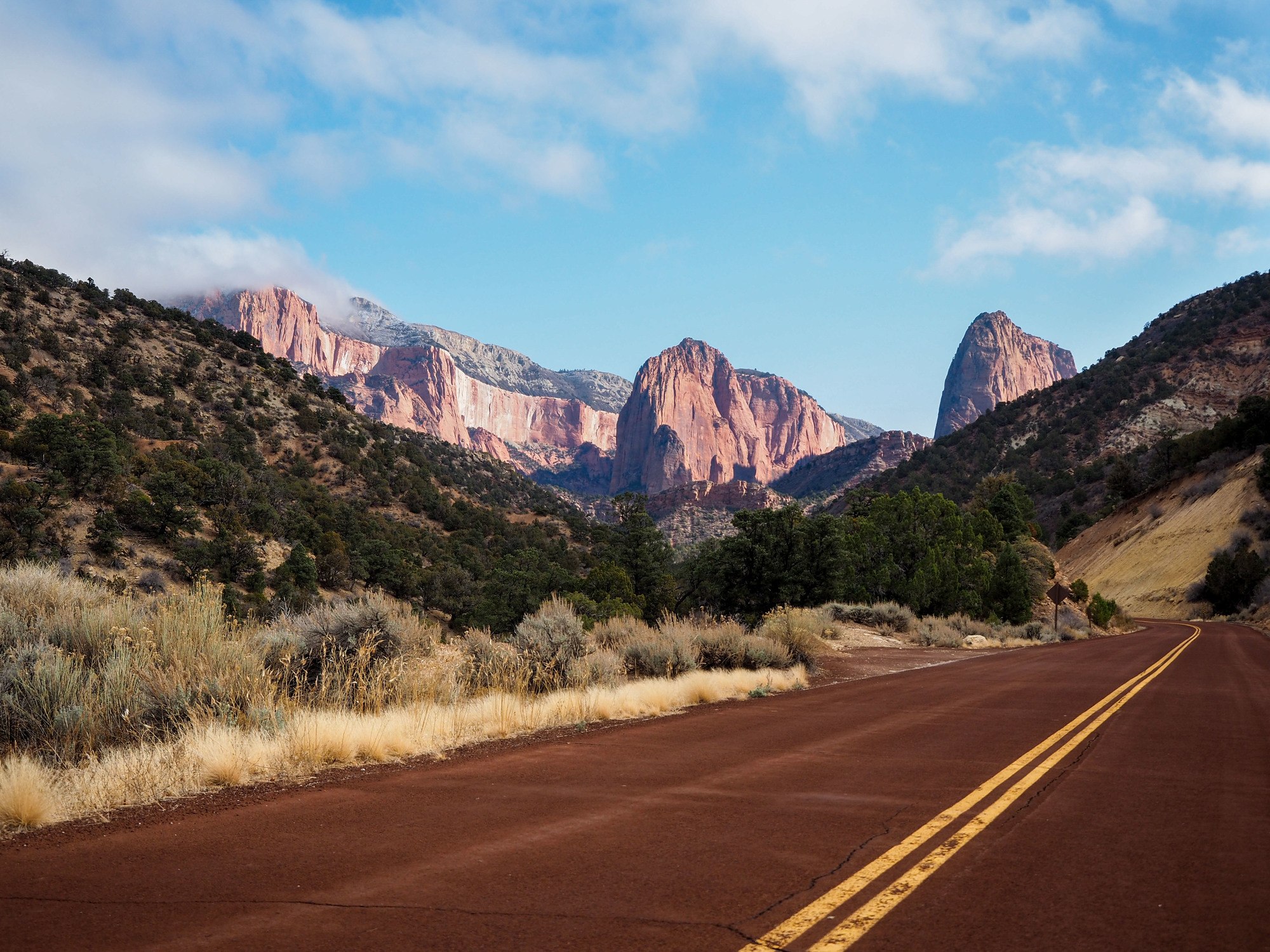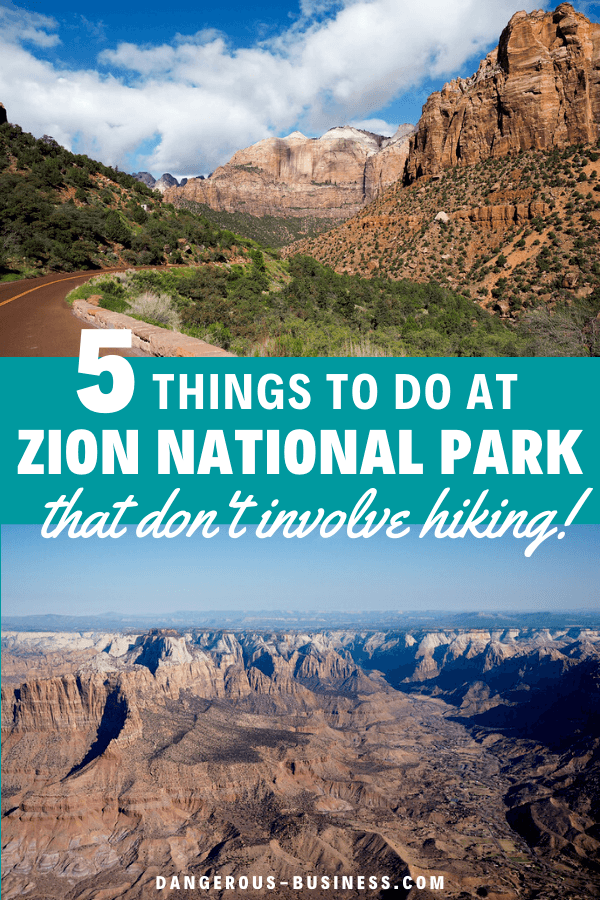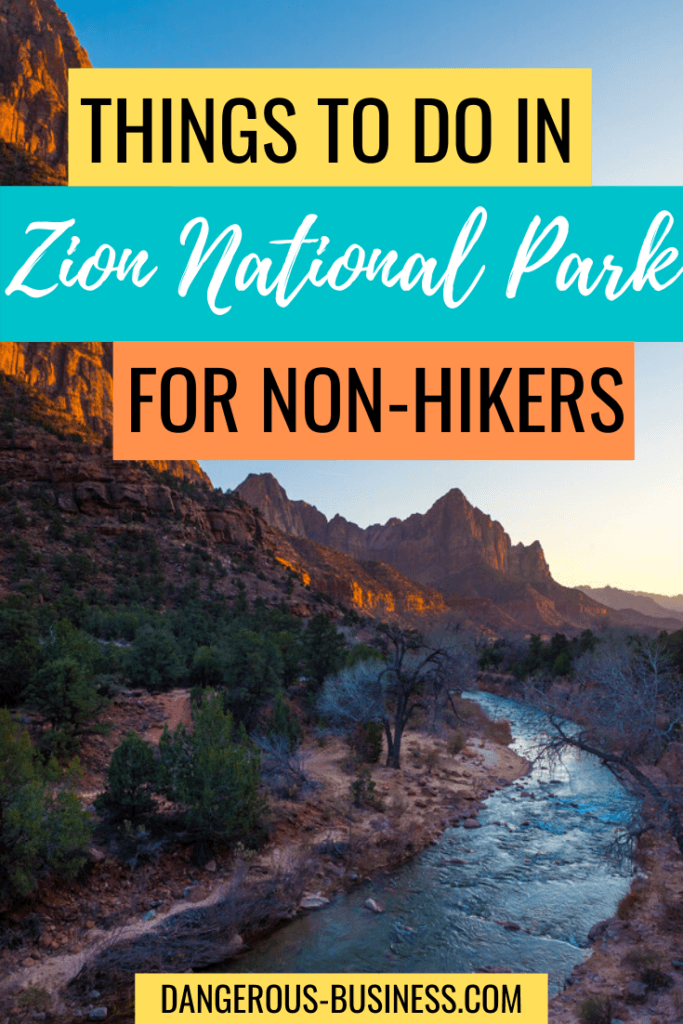5 Things to Do in Zion National Park That Don’t Involve Hiking

When it comes to national parks in the United States, the secret has long been out about Zion National Park. It's one of the most-visited national parks in the country, with millions of visitors flocking year-round to see its famous red canyon and to hike its famous trails.
And while hiking in Zion National Park is indeed amazing, I've gotten emails from people asking if that's the only thing to do in Zion. The answer is no.
Yes, Angels Landing and The Narrows are favorite hikes for lots of people, and I *would* suggest trying to tackle at least one of them if you're able. But if you're not physically able to hike for miles (or if you just really detest hiking), the good news is that you can still enjoy Zion National Park without ever lacing up hiking boots.

Here are 5 things you can do in Zion National park that don't involve any serious hiking.
5 Things to Do in Zion National Park That Don't Involve Hiking
I've personally visited Zion National Park several times, at different times of year. While I've done a couple longer hikes, I've also enjoyed all these non-hiking things, too!
1. Go for a short walk
While Zion does indeed have a fair number of challenging hikes, it also has a handful of really easy walks that will still get you up-close to all the great scenery of Zion National Park.
The easiest walks in Zion include:
- Pa'rus Trail – 3.5 miles roundtrip from the South Campground to Canyon Junction, following the Virgin River. This trail is paved and suitable for wheelchairs, and you can also walk your dog on it.
- Riverside Walk – 2.2 miles beginning at the Temple of Sinawa, following the Virgin River through a narrow canyon. This trail is also paved.
- Lower Emerald Pool Trail – 1.2 miles roundtrip from Zion Lodge. A paved trail leads to a waterfall at the Lower Emerald Pool. It also connects to the (steeper) Kayenta and Upper Emerald Pool trails.
- Canyon Overlook Trail – 1 mile out and back trail that is a little more challenging, but offers incredible views for little effort.
And you can always just do a portion of a trail, too. For example, the West Rim Trail (which eventually leads to the Angels Landing hike) starts out fairly flat; you could easily just walk a section of it and then turn around.
2. Rent a bike and ride Zion Canyon
You can see Zion National Park on two wheels, too. The only trail in the park you can ride a bike on is the Pa'rus Trail, but you can cycle the Zion Canyon Scenic Drive year-round.
During the winter months you'll share this road with cars. But from February through November (when the Scenic Drive is closed to normal traffic), you only have to share the road with park shuttles.
During the season that the shuttles run, they all have bike racks on the front. A popular thing to do is to take a shuttle to a stop near the end of the Scenic Drive (Big Bend would be my pick) and then ride your bike back through the canyon to the visitor center – or even all the way back into Springdale, since riding that way is almost entirely downhill.
(Though you can certainly bike both ways! The Scenic Drive is all paved and doesn't really have any steep hills.)
You can rent bikes or even book Zion cycling tours in nearby Springdale. Check out Zion Outfitter, Zion Cycles, or Zion Adventure Company for rentals and/or tours. Or you could try this Zion bike tour that can be customized for your group.
3. Drive the Mount Carmel Highway
While you can only drive through Zion Canyon in your own car a few months out of the year, you can always drive the Mount Carmel Highway.
This 12-mile highway connects the south and east entrances of Zion National Park, and driving it is an experience in itself. You traverse up and down steep switchbacks, and pass through the 1.1 mile-long Zion-Mt. Carmel Tunnel. Eventually the highway meets up with US 89.
Make sure to allow extra time for this drive. There are sometimes delays at the tunnel (if large campers or trucks are driving through, for example, they'll shut down traffic from one side since the tunnel is so narrow), and you'll likely want to stop multiple times at pull-outs for all the great views.
Just make sure that if you're stopping to take a photo that you do so in a designated pull-out; don't block the road!
4. Drive the scenic drive at Kolob Canyons
Did you know that there are actually two sections to Zion National Park? The “other” section – i.e. the one a lot of people don't even know about – is the Kolob Canyons section, 40 miles north of Zion Canyon.

To reach this part of the park from Zion Canyon, you have to exit Zion and drive back to I-15. It takes about 45-60 minutes to drive from one section to the other, but I promise the detour is worth it!
There are some hiking trails in the Kolob Canyons section of Zion, but the real star here is the scenic drive. It's only about 10 miles roundtrip from the visitor center to the Kolob Canyons Viewpoint, but it's a stunning drive with plenty of places to stop for views.
And the best part about Kolob Canyons? It sees only a tiny fraction of the visitors who go to Zion National Park every year, so you don't usually have to worry about traffic back-ups or jostling for parking.
5. See Zion from a helicopter
Lastly, if you want a real adventure and a completely different perspective of Zion, consider booking a helicopter tour.
Zion Helicopters in Hurricane, Utah, offers a variety of different tours that take you around the outskirts of the park from the air. (You don't get to fly directly over Zion National Park as it's not allowed, but you get close enough to look up Zion Canyon and pick out landmarks like Angels Landing!)
I did this on my most recent trip to southern Utah, and it was incredible to see all those craggy, canyon-y landscapes from the air. It gives you a deeper appreciation for what Mother Nature can create.
I booked the 35-minute Zion tour, which starts at $169 per person. (Note that you need at least 2 people for a flight.)
You can book a Zion area helicopter tour here (shorter tour) or here (longer tour that also includes the Canaan Cliffs).
Bonus: Watch the sunset at The Watchman
You can always just enjoy the natural beauty of Zion National Park, too. One of my favorite parts of my most recent trip was standing on the Canyon Junction Bridge and watching the sun set and paint the Watchman (a famous peak in Zion) a brilliant red-orange.
There weren't any clouds in the sky to make for a truly mind-blowing sunset, but it was still incredibly beautiful.

You can also ride the shuttles (or drive) through Zion Canyon, and enjoy lunch with a nice view at Zion Lodge.
Things to do near Zion
There's a ton to do in the Springdale area, too. These activities aren't *IN* Zion National Park, but they're close by!
Is it really worth visiting Zion if you don't hike?
Umm, have you seen the photos in this post? Absolutely yes! The landscapes and scenic drives in Zion National Park are absolutely worth it, even if you have no desire to hike.
Where to stay for a trip to Zion National Park
The three main Utah towns to use as bases for a trip to Zion National Park are Springdale (just outside the main entrance to Zion), Cedar City (close to Kolob Canyons), and St. George (about an hour from Zion).
You can also stay IN Zion at Zion Lodge or at one of the park's campsites, but the lodge is quite expensive, and both it and the campsites book up months in advance.
I've personally stayed in both Springdale and St. George, and recommend both for different reasons.
1. Springdale, Utah as a base for Zion

Springdale is ideal if the purpose of your trip is strictly to visit Zion. You can catch a shuttle into the park from downtown, and there are plenty of hotels and restaurants to choose from (though be aware that many eateries close during the winter).
I stayed at the La Quinta Inn & Suites Springdale and would definitely recommend it. Another good hotel option is Springhill Suites by Marriott, or you could book a cute cottage at Red Rock Inn Cottages.
If a vacation rental is more your speed, you could try this townhouse in Springdale (great for families), or the historic Rose Cottage.
2. St. George, Utah as a base for Zion
St. George is a little further away from Zion National Park, but is ideal if you'd like to base yourself in more of a city and plan to visit other nearby spots (there are some amazing state parks near St. George, like Snow Canyon!).
I stayed at the Hyatt Place in St. George, which has great access to I-15 for getting around and going to Zion.
For vacation rentals, you could check out this 2-bedroom home in Lava Falls at Entrada, this cozy casita in a golf community, or this incredible house on Red Hill that can sleep 24.
RELATED: St. George, Utah: More Than Just a Gateway to Zion
When to visit Zion National Park
Zion National Park is open year-round – and is popular year-round. The climate in this part of Utah remains fairly mild even in the winter, meaning you can do many of the things on this list even in the off-season. (Read about visiting Zion in winter here.)

Shuttles start operating in the park each year in February or March, and usually run through early November. When the shuttles are running, there are no cars allowed inside Zion Canyon.
During the highest of high seasons (spring break, mid-summer, and Labor Day weekend), park shuttles can be crowded and it can sometimes take a while to get where you want to go inside the canyon.
Early spring, mid-fall, and winter would probably be my picks for when to visit, especially if you want to avoid the worst of the crowds.
READ NEXT: A Perfect 10-Day Southwest Road Trip Itinerary
Did you know there were so many things to do in Zion that don't involve hiking? Which one would you choose?
Pin it for later:



Amanda Williams is the award-winning blogger behind A Dangerous Business Travel Blog. She has traveled to more than 60 countries on 6 continents from her home base in Ohio, specializing in experiential and thoughtful travel through the US, Europe, and rest of the world. Amanda only shares tips based on her personal experiences and places she's actually traveled!




















We want to just drive and see Zion National Park – no hiking – just to pass by – do you have driving directions on where to go and see the landmark? After Zion, we also want to see Bryce Canyon – no hiking just to pass by and see the landmark
You can check out this post for some more ideas: https://www.dangerous-business.com/mighty-5-utahs-top-national-parks/ In Zion, I would drive the Mount Carmel Highway. If you visit from March-November, you cannot drive in the actual Zion Canyon itself in your own car; access to that is by shuttle bus only (but you could enter and just ride the bus if you just want to see it). In Bryce, you can do the scenic drive (there’s only 1 road through the park) and stop at all the viewpoints. Note you’ll have to pay the entry fee at both of these.
Hi Amanda,
My wife and I (in our late 70’s and another couple (in their early 80’s) are planning a driving trip to the southwest to visit the National Parks in late September and early October. I happened on your itinerary which is everything we want to do. I purchased and downloaded your 10 day itinerary and am really looking forward to this trip. Since we are up there in age but in relatively good shape the information on driving trips was especially of interest since we can only do 1-2 mile hikes. The additional information on where to stay and where to eat is very helpful.
Thank you for what you do and if there is any other information to help with this trip, please let us know.
Thanks again,
Denny Belden
You’re very welcome, Denny! I hope you have an excellent trip. All my tips are all here in various forms on my website, and it looks like you’ve found most of those!
WOW! Very nicely written and some really great, comprehensive information about Zion National Park. Thank you! My friend and I are in our 60’s, and we will definitely use the info. obtained here for our upcoming trip in September 2021.
Excellent advice! Very helpful. I’m an older person and don’t particularly like hiking— that is, hiking in forests. But I think the trails you mention will be very enticing for me. And the bike rides. Thanks!
These trails are definitely a lot different than hiking in a forest! But luckily there’s a lot to do other than hiking to still admire the scenery.